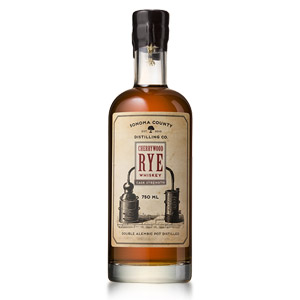I have been remiss, on this blog, in my (total lack of) coverage of High West’s excellent whiskies. I think some part of my brain decided that the celebrated Utah blender/bottler (and now distiller) got plenty of attention from other blogs and media outlets, and thus didn’t need any from me. That’s a lame justification, and I plan to review more High West whiskies in the future, starting today with High West’s Double Rye! Yes, the exclamation point is indeed part of the whiskey’s name. I’m not quite sure how you’re supposed to pronounce it. Are you expected to yell it? Or perhaps, emphasize the ‘Rye!’ part such that people wonder if you have a condition. “Here you go, a nice glass of Double RYE!” I’m a hit at parties.
Double Rye! is a blend of straight ryes. This means the bottle, itself, cannot be called a straight rye. Aren’t legal definitions fun? The ryes in question are a 95% rye (5% malted barley) mash bill from MGP, and an 80% rye (20% malted rye) distilled by High West themselves at their new-ish distillery in Park City, Utah. The MGP rye is younger (at least 2 years of age) and column-distilled. The High West portion is older (a house blend containing High West straight ryes between 4 and 7 years) and is distilled on a copper pot still. Both ryes are aged in new, charred American oak. The ratio of the two components is a secret, but we do know that the older High West component is in the minority. The whiskey is not chill-filtered (nor carbon filtered) and is bottled at 46% ABV. My bottle is from Batch 18G26.
In an interesting departure from the usual startup distillery business model, High West does not intend to replace all of its sourced whiskey with house-made distillate. Instead, it plans to maintain the brand’s current flavor profiles by replacing certain components with specifically-made house whiskies.
Note that bottle batches that begin in 18 (or higher) are the above recipe, which debuted in 2018. Lower numbers indicate the older recipe, which was made with MGP rye and 16 year-old Barton rye, a whiskey that is now impossible to find. If you see a bottle from the old batches at the same price, snag it, there won’t be any more.
Nose: Complex, with a distinct “young rye” eucalyptus/menthol note that is well-balanced and held in check by a malty sweet cinnamon-roll character, complete with that sinful white confectioner’s glaze. Deeper in the glass, there are some rye grain and flour notes (bready, yeasty, nutty).
Palate: Syrupy body. Moderate to severe tongue burn – a little hot for 46% ABV. Again, the sweetness of the older rye perfectly balances the vibrancy and grassiness of the younger. Both are detectable. Toasty, nutty, sweet, and complex. Nice.
Finish: Medium or medium-long. All of the previous notes continue into the finish. Fades with a dash of charcoal, but no bitterness.
With Water: A few drops of water serve to integrate the components more fully – it’s now harder to discern the young rye and the old rye. Beyond that, the palate gains a hint of bakery goodies… monkey bread? Water optional.
Overall: Pleasant, well-balanced, and just complex enough to justify the price. Some of the particularities of this whiskey are likely to be lost in a cocktail, although if you’re used to a bottom-shelf rye in your Manhattans, this is going to be a noticeable step up. As a mixing rye, though, I don’t think it’s necessarily better than Rittenhouse 100 or Hochstadter’s, which are both more straightforward, but less eclectic and more suited to “house rye” status. Still, if you like to occasionally sip your middle-shelf ryes then High West delivers, and for quite a reasonable price. I sure wish I could compare this to the old Barton recipe, however…









Ah nice, my barely-cracked-into 375 has a batch number starting with 16. It’ll be interesting to compare it to their latest stuff.
Don’t know if they changed the label, but they do provide some reasoning for the “!” on the back of the bottle. No pronunciation tips though…
This was my main spirit for years, but in the last year the taste just hasn’t been the same. I did a little research and saw it was reformulated right around when I noticed the change.
I think this stuff is awful. They must have screwed it up somehow. Barely drinkable. Maybe I can use it as hand sanitizer.
Agree, the bottle we had looked promising given all the marketing “glowing” reviews. It tasted in our opinion like stale flatulence. Cant return the bottle. Used as santizer.